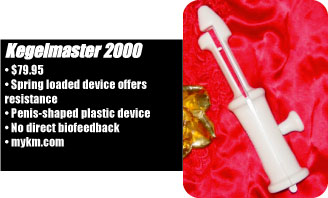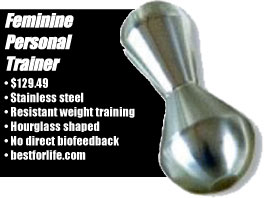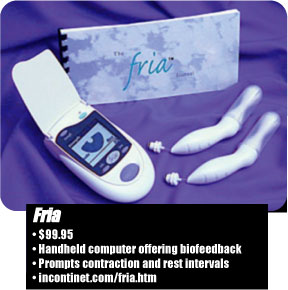Samantha, in an episode from Sex & the
City, does invisible vaginal exercises in
the middle of a diner. One can imagine the mantra
running through her head. Instead of the old
middle school cheer, "We must, we must, we must
increase our busts," Samantha's chanting "I
will, I will, I will tighten my vagina."
We've
heard about them since adolescence, but what
are they? Kegel exercises. Kegels are contractions
that strengthen and tighten our vaginal muscles
like weights help tone our arms, abs and butts.
Kegelling enhances your sex life by tightening
up the muscles that contract when we climax.
Furthermore, it prevents or reverses incontinence
and strengthens the pelvic floor muscles after
childbirth. Better still, there's no harm in
doing them--as long as you isolate the
kegel muscles. As teenagers we learn to do them
merely by squeezing, but there are some devices
available that facilitate and expedite your
efforts.
"Even
thousands of years ago tantric practitioners
knew and acknowledged that a woman's vagina
loosens through repeated sexual acts. But as
humans developed a more sedentary lifestyle
we thought less about these kinds of things,"
says Jay Waller, president of Kegelmaster Worldwide.
"The pubococcygeal muscles have a more important
purpose than sex: they support the bladder,
the uterus and the rectum. Sex and childbirth
may stretch the muscles and therefore lead to
incontinence later in life."
In fact
it was because of incontinence that kegelling
first started. In the 1950s Dr. Arnold Kegel,
a Los Angeles gynecologist, developed a biofeedback
device known as the perineometer to help women
suffering from incontinence. Weeks after using
the device, his patients--housewives--reported
significant orgasmic enhancement. He understood
that by isolating the pubococcygeal muscles
(now commonly known as kegel muscles), women
could reverse incontinence. But he also recognized
that merely squeezing these muscles wasn't enough.
That's
why sexperts agree that biofeedback is important--though
more so for women well into their middle ages.
Wendy Halbert, a urological services nurse practitioner
whose office assists women with incontinence
and similar problems, uses a vaginal or rectal
probe hooked up to a computer to determine the
effectiveness of a patient's kegel contractions.
The computer shows a clinician if the patient
is performing the exercises correctly and to
what extent--or more simply, it shows how tight
her pelvic floor is. How quickly the patient
experiences results depends on how weak the
muscles were when they began therapy and how
faithful they are with the exercise regime,
she says.
While
Halbert doesn't counsel her patients on the
sexual aspects of kegel exercises, she says
many of her patients have bragged of "improved"
sex lives. Nevertheless, she says, "I am a firm
believer that if women of childbearing age would
do these exercises faithfully post partum and
throughout their lives, we would not see the
huge problem of urinary incontinence that we
see now." 
Karen
Corkery, a gynecological nurse practitioner,
agrees. Just as important as isolating the kegels
is biofeedback for women middle aged or older
or for women with more severe pelvic problems.
Biofeedback machines measure and chart a patient's
muscular development and progress, which offers
both the patient and doctor the most information.

Dr. Barnaby
Barratt, president elect of the American Association
of Sex Educators, Counselors and Therapists,
explains that tools offering resistance most
effectively help isolate the proper muscles.
Many people he counsels often mistake pelvic
floor muscles, perineal muscles, abdominal muscles,
gluteal muscles or the anal sphincter instead
of vaginal muscles, rendering kegelling counterproductive.
While, like Corkery, he recommends products
providing biofeedback, he says using a finger
inside the vagina while kegelling also gives
feedback.
"This
isn't rocket science," he says. "This is an
easy way for  women
to check out the success of their kegel exercises.
Insert two fingers--the index and the middle--in
a V shape and see if you can close the vaginal
walls over them. This tells how much pressure
the muscles can exert and how in-shape the vaginal
walls are."
women
to check out the success of their kegel exercises.
Insert two fingers--the index and the middle--in
a V shape and see if you can close the vaginal
walls over them. This tells how much pressure
the muscles can exert and how in-shape the vaginal
walls are."
Another
way to isolate the kegels is to visualize which
muscles shake and quake during orgasm. Also
you can recognize them by trying to stop the
flow mid-urination; the muscles that stop your
flow are those same muscles you'll be working
out.
The devices
often resemble adult toys but using them feels
more like a gynecological visit than a journey
through a carnal carnival. In the long run,
though, significant sexual and medical empowerment
arise from kegelling, whether you squeeze or
use devices like the Fria, the Kegelmaster 2000,
or the Feminine Personal Trainer.
Take it
from Rachel Fallaci of Carlsbad, CA. "Sometimes
I [kegel] instead of working out during the
middle of the day when my husband's not around,"
she says. She and her husband often jumpstart
their lovemaking by incorporating the Kegelmaster
2000 as foreplay. "For women who have trouble
getting in the mood or reaching orgasm, using
the Kegelmaster as foreplay totally fast forwards
things."
Fallaci
admits that kegelling improved sexual relations
with her husband within five weeks. Now, she
says, she's empowered with a "kung foo grip"
so tight and strong that her husband sometimes
has to ask her to take it easy.
Also popular
is the Fria machine, a plastic bulb about the
size of a thumb which gives biofeedback readings.
This product offers direct feedback about how
much the muscle strength is improving. One model
called "MySelf" automatically adjusts to your
individual performance and displays each contraction
level.





